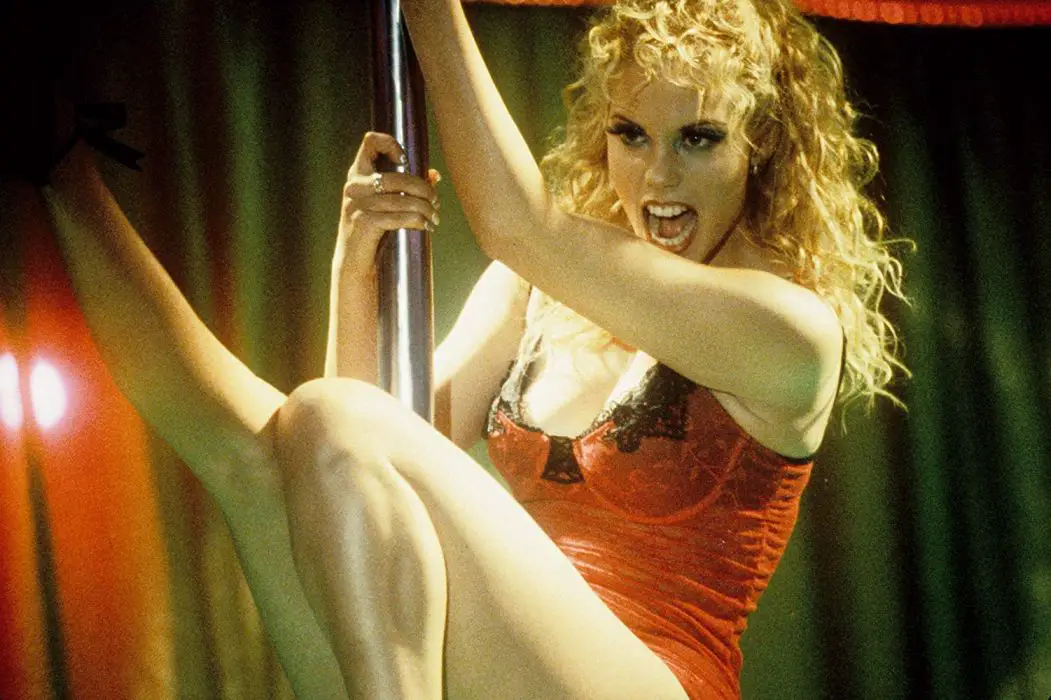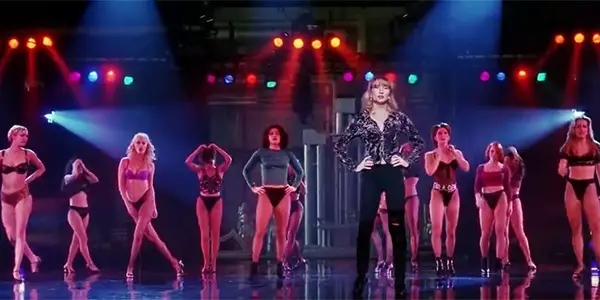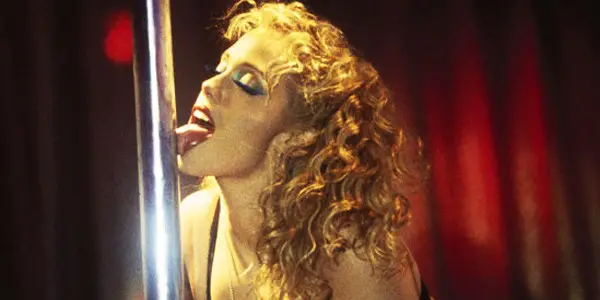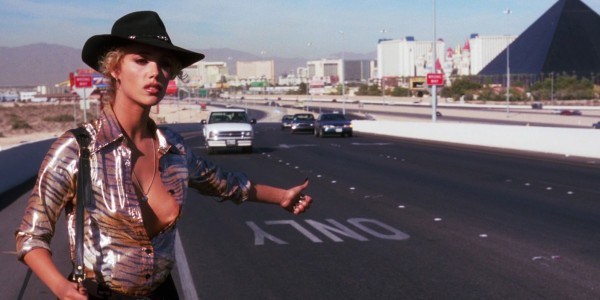The Passion Of Nomi: SHOWGIRLS In The Arthouse

John Stanford Owen received his MFA from Southern Illinois University,…
“They’re not sticking up. Stick ‘em up,” barks Tony Moss.
In his first encounter with Nomi Malone, the sleazeball producer feels entitled to critique the flaccid state of her nipples. “Play with them. Pinch ‘em a little. You want me to do it for ya?” He continues to berate her in a style that suggests he believes this person exists as his property. Meanwhile, Paul Verhoeven’s direction creates such a visceral experience that the audience smells the remnants of last night’s booze on the character’s breath.
Before Tony’s areola appraisal, he establishes his cantankerousness with the introduction “Some of you probably heard that I am a prick. Well, I am a prick.” But he solidifies that schtick in a most vicious manner when he dresses down a line of auditioning dancers one by one, walking down the aisle the way someone inspects automobiles, kicking tires and searching for scratches to uncover any possible flaw. This one’s ears stick out too far. Another needs to lose the baby fat. That girl’s breasts belong in a watermelon patch.
While the chorus of cruelty rattles on, all of these performers stand at military attention, as if to brace themselves for the emotional burns his acidic words leave behind. But Nomi? She got accustomed to waspish men a long time ago. Before she landed at Las Vegas’ Stardust Hotel, she lived an even more sour existence than the cold reality of now.

Despite how Nomi absorbs sadistic psychological abuse, her present situation soars above her past, a backstory that, at this point, remains the movie’s central mystery. The one thing we know: she stays hyper-focused on doing whatever it takes to never return. So when Tony demands she perk her lifeless nipples to stiletto sharpness, she tosses the ice-cubes he offers back in his smug face.
Nomi seeks change—of situation, self, and society—but despite her best efforts, circumstances never budge an inch.
Showgirls Belongs in the Arthouse
Through the prism of Showgirls, Paul Verhoeven excavates the insidious secrets we keep buried deep beneath the floorboards. In fact, Tony Moss’ provocation provides only one example of the film’s ongoing investigation into what causes the rot and withering away of human decency. What happens when someone like Nomi, a person with a less-than-savory past, attempts to reverse a societal plague? To what degree do we the audience bear responsibility for this mess?
As it exposes and explores cutthroat behavior on the granular level, the movie answers big-picture questions about our penchant for self-destruction and what it takes to rise above the awful ruckus. These pillars remain integral from start to finish, because Showgirls, by any measure, epitomizes every tenet of arthouse cinema. Not a so-bad-it’s-good film. Not a surface-level entertaining film punished for its NC-17 rating. Showgirls belongs on a shelf alongside Andrei Rublev, The Seventh Seal, and The Passion of Joan of Arc.
Over the years, audiences found joy in Nomi’s thrashing dance moves, and thus the film rose up and danced away from the graveyard of commercial and critical flops. Though, even with financial success and audience appreciation, the irony factor creates a miscategorization of Showgirls’ intent.
In fact, the film delivers an updated version of “Macbeth,” Shakespeare’s tragedy that explores the bloody price that ambition demands, but Paul Verhoeven’s cinematic masterpiece focuses less on the retelling of that story, and more on reinventing it in a way that improves the framework of rise-and-fall narratives.
In this vein, Verhoeven remains smirkingly aware of his craft, making a capital-P Postmodern movie that jettisons any notion of illusion. Ingmar Bergman prided himself on making that exact move, going so far as to reveal the camera itself, as if to say, “I am making a movie. It’s not real, but the message is.” From his time as a European arthouse provocateur to his work in erotic thrillers such as Basic Instinct, Verhoeven took incredible delight in working as a puckish, mischievous filmmaker. When it came time to commit Showgirls to celluloid, you better believe he intended to exploit the film’s garishness.
Even the Las Vegas tourist board markets the destination as an excuse to unleash a person’s most debaucherous self. The film grants us the same permission. After all, he wants the audience in on the joke. We may not wear the sequined bodysuits and peac*ck-spanned headdresses, but we remain an integral part of the show. Perhaps more so than we realize.
The Miscategorization of Masterpiece
“Showgirls is the only realistic movie I made in the United States.”
Paul Verhoeven declared this in an interview with Adam Nayman, the writer who penned a book-length defense of a film that critics called “vile,” “garish,” “laughable,” and “gross.” Those descriptions, it turns out, ring true, though they aim at the wrong target. The directors’ assertion that Showgirls marks his most matter-of-fact work indicates that the world as a whole, not the movie that exposes its true nature, falls under the category of vile, garish, laughable, and gross. In other words, society bites the big weeny, and the movie seeks to tell the truth about it.
Nevertheless, the punishing reactions, many more over-the-top than star Elizabeth Berkley’s Razzie-winning performance, kept piling on back in 1995. Some of these diatribes continue twenty-five years later, but with the popularity of midnight screenings that welcome audience participation, the film found its footing, albeit on an accidental path.
In Nayman’s book, “It Doesn’t Suck”, the author likens the experience of the movie to a cinematic Rorschach test. “If the viewer wants to see a ‘piece of shit,’ chances are that he will; certainly enough people did and still do. If the viewer knows how to look, however, then Showgirls’ magnificence will reveal itself as grandly and nakedly as a striptease.” To piggy-back on Nayman’s observation, Showgirls never enjoyed the benefit of a clean slate. Those inkblots always existed.
Watching it these days, the audience goes in with an expectation of Rocky Horror Picture Show experience, and when the movie hit theaters twenty-five years ago, the critical butchering had already inflicted damage. But Showgirls’ reputation suffered before even one ticket got sold or any newspaper released a sharp-tongued review.
Taboos and Myth Creation
The film’s star power created a barrier to the film gaining the merit it deserves. Not long before she donned the Versace (pronounced “ver-sayce”) dress, Elizabeth Berkley played the straight-A, straight-edged Jessie Spanno on a Saturday morning kids’ show about teenagers who make positive decisions in challenging scenarios. And more than any other member of the gang, Jessie fits this goody-two-shoes model.
The character shows her friends kindness, champions equal rights, apologizes when she hurts someones’ feelings, and uses her privilege for the betterment of humankind, all while working toward Ivy League ambitions. Then the opportunity to tap into a taboo popped up.
One sunny day near the end of the Twentieth Century, the actor who brought Jessie to life appeared on a movie poster that hinted at the particulars of her natural state. And so the would-be masterpiece debuted with an ipso facto subtitle. Showgirls: You Get to See the Girl from Saved by the Bell Naked.

With all of these distractions, we missed something of vital significance, an element that makes Verhoeven’s proclamation that Showgirls marked his most realistic movie very true. As a work of art, the movie tells a story about human carnality, greed, and mercilessness, innate characteristics that we might offset but can never vanquish. The story critiques our thoughts and behaviors in a powerful way, calling for so much personal reflection that it redefines audience participation itself. Put another way, it allows viewers to take part, but through introspection, meditation, and self-realization. In short, Showgirls gives us psychoanalysis via cinema.
Psychoanalysis, Dodging Genre, and the Kubrick Connection
Though he had nothing to do with Showgirls’ production, Stanley Kubrick harbored some thoughts on the situation described above: “The most terrifying fact about the universe is not that it is hostile, but that it is indifferent.” The director’s sentiment speaks to the austere reality that the universe holds no obligation to deliver happiness, but his thought ends with a trickle of hope. “However vast the darkness, we must supply our own light.”
Kubrick, of course, gave us some of cinema’s most celebrated arthouse films, stories that ask existential questions about the nature of existence and where humans end up if they keep following the same behavioral patterns. He also used a whole bunch of sex and violence to illustrate his points. Meanwhile, Showgirls got thrown in the rubbish bin the moment it hit theater screens, though it tackles those exact narrative goals. Even as she weaponizes her sexuality, Nomi Malone supplies the light Kubrick spoke about, though most everyone she meets seeks to snuff it out.
To that end, Stanley Kubrick borrowed Paul Verhoeven’s heightened audience involvement routine. In the director’s final movie, Eyes Wide Shut, the story asks us what we find most important in several scenarios. For example, Dr. Bill Harford (Tom Cruise) answers the call to resuscitate an overdosing call girl. The c*cktail of heroin and cocaine seething through her bloodstream may cut her life short, but the camera nevertheless lingers on her naked body, a full display of the skin’s canvas lain slack as a rag doll across a chair. Should the audience pay mind to her recovery? Or her sexual allure?
In that regard, when we watch Showgirls, we catch a more than a passing glimpse at our worst behavior in action. We fail to see suffering if that plight stays covered in spidery eyelashes and cheetah print nail polish. To get his message across, the director needs a vehicle, which reveals why so much of his work in 80’s and 90’s implements heavy genre conventions and rules.
Verhoeven works not so much within the confines of a genre, but using the illusion of it. 1987’s Robocop gets lauded as a technophobic sci-fi masterpiece, but really functions as a finger-wagging critique of capitalism. With his 1995 masterpiece about Vegas nude dancers, he dives deeper into the erotic thriller, adding a satirical layer to the vagina-flashing tone he established in his previous film, Basic Instinct. But, in the end, Showgirls is less about dancing, or sex, or ambition. The movie focuses on our own peccadilloes. It shines the interrogation light on us, our poisonous thinking, and the lies we tell ourselves about virtue.
Conclusion: Scene, Character, and Self
Confession: I stand at the end of a long line of writers who hold Showgirls in high esteem. Articles, books, and video essays keep dripping down the pipeline, most of which praise the film for all the comedy we missed. And yes, the movie contains a whole bunch of funny bits. Let us not forget spastic dancing, which touts aggression over eroticism. In fact, there exists little difference between her moves and fight choreography. Call it serendipity, but the comedy element allows Verhoeven to hold up three mirrors: scene, character, and self.
Consider the cocaine-fueled pool sex scene that mimics the movements of a dolphin. While that coitus chaos happens, an actual dolphin statue spits water above the two lovers. Meanwhile, Verhoeven stands behind the camera, winking at us. And this example identifies only one moment of narrative chirality. Notice how the movie begins and ends inside the same truck with the same woman running away from a repeating problem?

The mirroring scenes happen quite on purpose, as do the characters who reflect one another in such a seamless way. Throughout the movie, the rising Nomi battles the established queen Cristal Connors. These dueling performers are not so much enemies as they are forces of energy unable to occupy the same space. The same rule applies to Tony Moss and Al Torres, who despite the economic chasm between them, make a living off the way in which they exploit women.
Last, exploration of our own moral wiring pops into the equation. The movie dives into one’s mind and looks repressed fears and old shames and unexplainable sexual appetites dead in the eye. More than anything, the film looks at the code of righteousness we design to act upon only in convenient moments, stripping back the philosophy of ethics to its primal state.
“That the ethic of conscience is intrinsically insidious seems scarcely a revelatory point, but it is one raised with increasing infrequency; even those who do raise it tend to segue with troubling readiness into the quite contradictory position that the ethic of conscience is dangerous when it is wrong, and admirable when it is right.”
When Joan Didion wrote her essay “On Morality,” she dove into the notion that the validity of human ethics comes to fruition only when an action or belief system ends with a favorable outcome. Turns out, Paul Verhoeven made a movie about this exact thing, and in the end, it shows the audience the innate toxicity of human behavior.
To be clear, the director does not point fingers, or claim to be above toxic thinking. He asks for our awareness, as if to say that, only through conscious thinking and the use of kindness as an actionable tool can we rise above the fray. You see, as we watch Showgirls, we choke back church giggles at the hammy dialogue, the martial arts dancing, and the most un-sexy love scenes in the history of celluloid.
And then a brutal gang rape happens near the end of the third act, a gutwrenching moment wherein one perpetrator’s fist smacking against his target’s eye sounds like raw meat hitting linoleum. The laughter comes to an abrupt stop then. In fact, many emcees who host the film as a comedy happy hour skip over the rape scene so as to not make the audience feel guilty for their previous mocking.
But therein lies the hangup: we giggled at human suffering for two hours, but when the tone changes, we catch sight of where we went wrong. Suddenly, someone holds a mirror up to us. It feels uncomfortable. It is supposed to feel uncomfortable. Change is painful.
Is Showgirls an arthouse classic?
Does content like this matter to you?
Become a Member and support film journalism. Unlock access to all of Film Inquiry`s great articles. Join a community of like-minded readers who are passionate about cinema - get access to our private members Network, give back to independent filmmakers, and more.
John Stanford Owen received his MFA from Southern Illinois University, where he also taught English courses. When JSO is not penning reviews and essays on cinema, he's reading and writing poetry, walking with his dog, or dancing to Radiohead.












